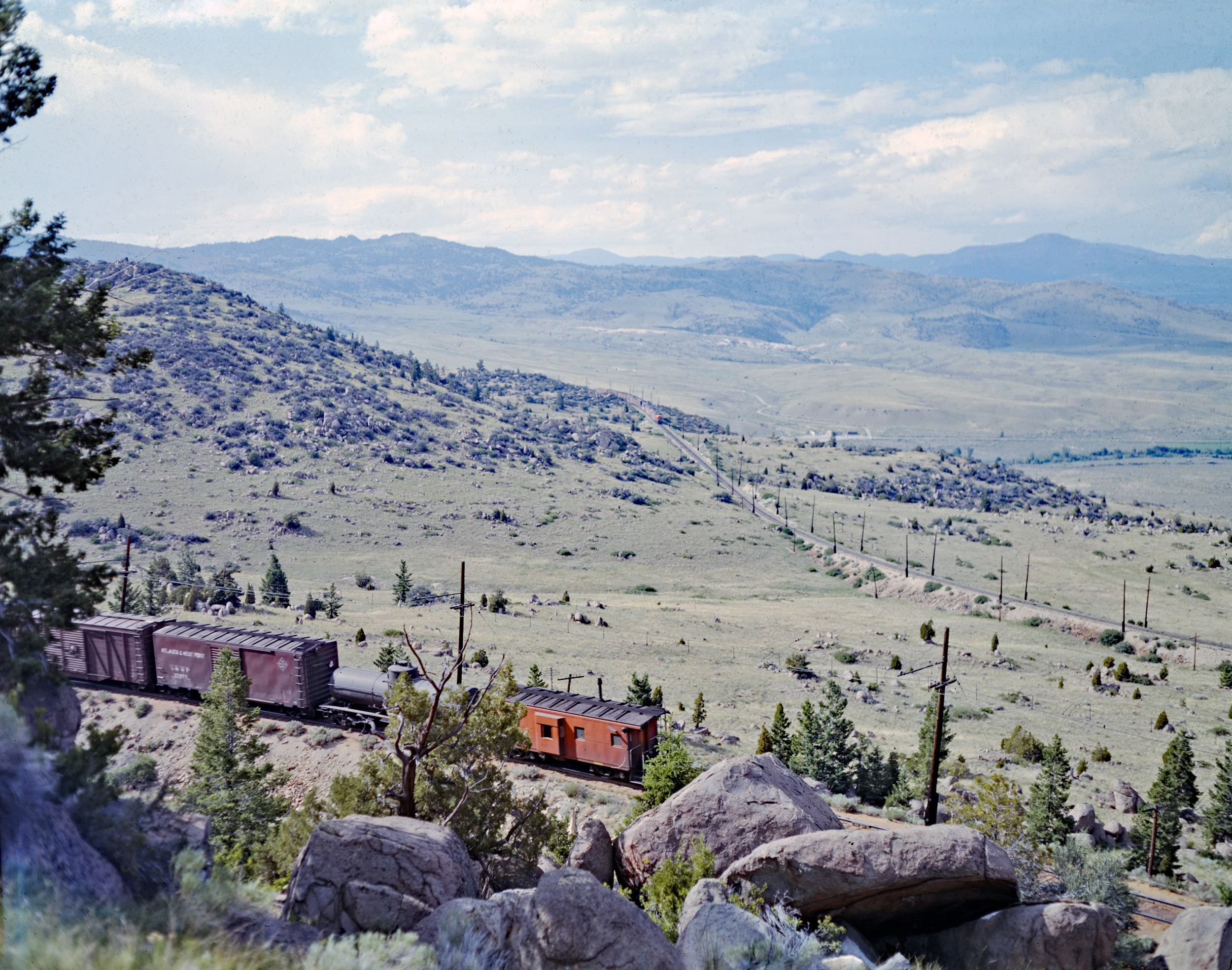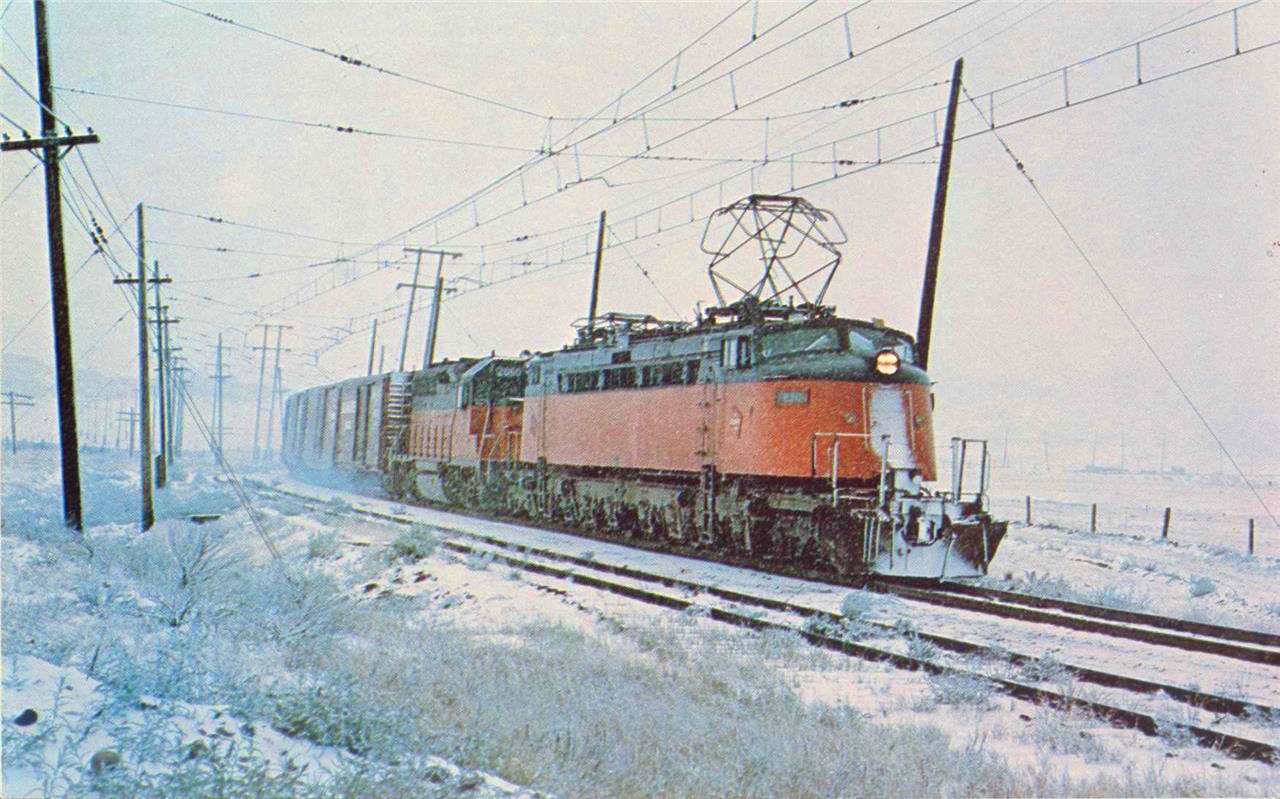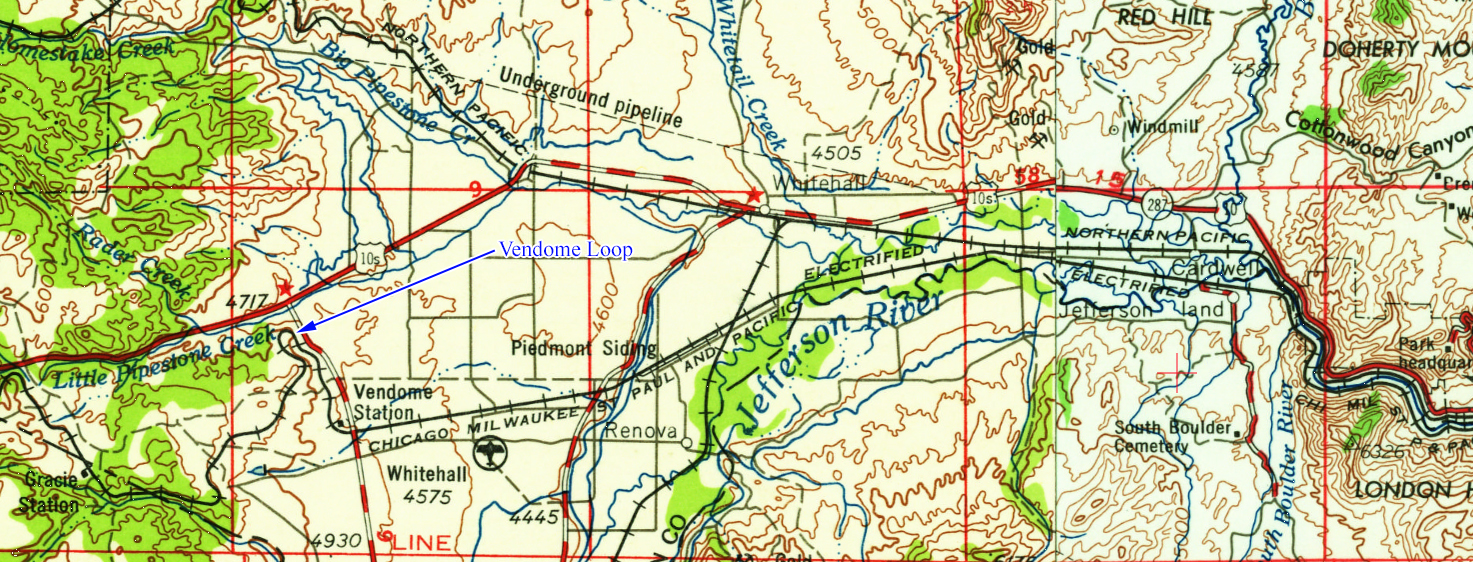Milwaukee Road's "Vendome Loop" (MT): Map, History, Photos
Last revised: November 6, 2024
By: Adam Burns
Often forgotten in the annals of history are the majestic and impressive engineering feats the Milwaukee Road carried out in completing its Pacific Coast Extension. One of these projects was Vendome Loop, located between Butte and Three Forks, Montana.
Constructed as a means of gaining elevation with the line entering the eastern edge of the Rocky Mountain foothills along a stretch known as the Highland Mountains.
It was the first in a series of engineering projects to keep grades manageable through the Highland Mountains. The loop kept grades at a manageable 1.5%-2% as the railroad gained elevation towards the pass.
It was an impressive engineering marvel and would no doubt attract many enthusiasts and sightseers today if the route was still in operation.
Photos
 A Milwaukee freight (train #263) descends Vendome Loop eastbound near Cedric, Montana led by two "Little Joe's" (way off in the distance on the other side of the giant horseshoe curve) on June 22, 1959. Ron Nixon photo/Museum of the Rockies collection.
A Milwaukee freight (train #263) descends Vendome Loop eastbound near Cedric, Montana led by two "Little Joe's" (way off in the distance on the other side of the giant horseshoe curve) on June 22, 1959. Ron Nixon photo/Museum of the Rockies collection.History
Few rail lines, let alone railroads, have garnered such interest, intrigue, and awe as the Chicago, Milwaukee, St. Paul & Pacific's Pacific Coast Extension, even 40+ years since it was abandoned.
It was a massive project that extended the railroad's reach from the Midwest to the Pacific Northwest, spanning across states like Idaho, Montana, and Washington.
Completed in 1909, it was considered an engineering marvel of its time. However, due to financial struggles, the Milwaukee Road ceased operations on the extension in 1980.
Since its abandonment the debate has raged regarding the line's viability. One publication described it as the "longest branch line." For many years the extension struggled to earn a true return on its investment. However, over its final decade the route was profitable but was nevertheless removed.
In 1901 the first surveying work began and it was estimated the more than 1,400-mile western extension would cost the railroad around $45 million adding more than 25% to its total system mileage. However, four years later this number was adjusted to $60 million.
 Milwaukee Road "Little Joe" E-70 and GP40 #2060 (30-ERS-4) descend the east side of Pipestone Pass along the sweeping Vendome Loop (Montana) with an eastbound freight making its way towards Three Forks during a late summer's snowfall on September 7, 1973. Vendome was one of the many impressive engineering feats carried out during construction of the Pacific Extension. The following June the electricity would be turned off. Margret Lewis photo.
Milwaukee Road "Little Joe" E-70 and GP40 #2060 (30-ERS-4) descend the east side of Pipestone Pass along the sweeping Vendome Loop (Montana) with an eastbound freight making its way towards Three Forks during a late summer's snowfall on September 7, 1973. Vendome was one of the many impressive engineering feats carried out during construction of the Pacific Extension. The following June the electricity would be turned off. Margret Lewis photo.What made the extension so terribly expensive was acquiring the needed right-of-way. Unlike the Great Northern and Northern Pacific the CM&StP was not given free government land grants.
As a result, it not only had to both purchase land from private owners but also acquired small railroads in an attempt to reduce construction costs. Despite these hurdles the railroad's management in the early 20th century prevailed.
Amazingly, in just three short years the entire extension had been completed and on May 19, 1909 a Golden Spike was driven at Garrison, Montana commemorating the opening of the new route.
During surveying, the extension was broken down into various segments all of the way between South Dakota and Washington state to complete the line as quickly as possible. The segment within which Vendome Loop was constructed was along a stretch between Lombard and Butte, bisected by the Continental Divide at Pipestone Pass.
Construction
Survey work on this section began in 1904; roughly 20 miles west of Three Forks engineering and survey crews found themselves facing the Highland Mountains along the eastern edge of the Rockies. Up to this point west of Three Forks crews were able to survey a virtual tangent track in a southwesterly direction along the flat Jefferson River Valley.
With crews already surveying and working west of the Continental Divide, the team working to the east side of the divide decided the best way to gain elevation was via a sweeping loop hugging the mountainside as much as possible.
Building the loop, and grading the line in general, proved more difficult than anticipated due to the disintegrated and solid granite rock construction crews encountered when creating the cuts needed.
Actual work along this segment was contracted out to the McIntosh Brothers, which along with the grading work also constructed the bridges, culverts, and all other major work involved with the line.
Grades
Overall, engineers and construction crews were able to keep the ruling grade on the eastern slope of the mountain (where the loop was located) to 2% while the western slope featured just a 1.66% grade. The loop itself was, overall, roughly three miles in length.
Map
Luckily for the Milwaukee Road, the grade was very close to the Northern Pacific's main line, enabling men, machinery, and materials to be transported on-site rather quickly.
By 1908 the entire line between Three Forks and Butte,
including Vendome, was open to rail traffic although it required
using a tortuous temporary right-of-way over Pipestone Pass as the
tunnel was not completed for another year in 1909. For more reading about the Milwaukee Road please click here.
After the Milwaukee Road electrified much of its Pacific Extension a little less than ten years after the entire route was completed operations over Vendome Loop became a true sight to behold, which was further enhanced as trains became longer.
While watching trains over the loop meant gaining permission from local property owners and trekking up steep mountainsides, if one made the climb to the western segment it was sometimes possible to see the lead locomotives rounding the bend below, exiting off the mountain while the tail end of the train was still right in front of you.
With the abandonment of the Pacific Extension in March, 1980 Vendome Loop sits quiet today, an incredible engineering marvel that is no longer in use.
Sources
- Murray, Tom. Milwaukee Road, The. St. Paul: MBI Publishing, 2005.
- Ploss, Thomas. Nation Pays Again, The. Ploss (Self Published): January, 1985.
- Schafer, Mike. Classic American Railroads. Osceola: MBI Publishing, 1996.
- Scribbins, Jim. Hiawatha Story, The. Minneapolis: University of Minnesota Press, 2007.
- Scribbins, Jim. Milwaukee Road Remembered. Minneapolis: University Of Minnesota, 2008 (Second Edition).
- Sol, Michael (Milwaukee Road Archives)
- Solomon, Brian and Gruber, John. Milwaukee Road's Hiawatha's, The. St. Paul: Voyageur Press, 2006.
- Wood, Charles R. and Wood, Dorothy M. Milwaukee Road West. Seattle: Superior Publishing Company, 1972.
Recent Articles
-
Kentucky Christmas Train Rides On The "Santa Train"!
Dec 15, 25 11:10 PM
Where rail history and holiday magic meet in the heart of Kentucky’s horse country, the Bluegrass Scenic Railroad and its beloved Santa Trains offer families, railfans, and holiday enthusiasts an expe… -
Indiana Christmas Train Rides In La Porte!
Dec 15, 25 11:05 PM
Among the Hesston Steam Museum's standout events each year is the seasonal Santa’s Candy Cane Express, a holiday-themed train ride and festive morning-to-afternoon experience. -
California Christmas Train Rides In Campo!
Dec 15, 25 10:59 PM
Nestled in the Mountain Empire region of southeastern San Diego County, the Pacific Southwest Railway Museum. During the Christmas season they host the popular North Pole Limited.




